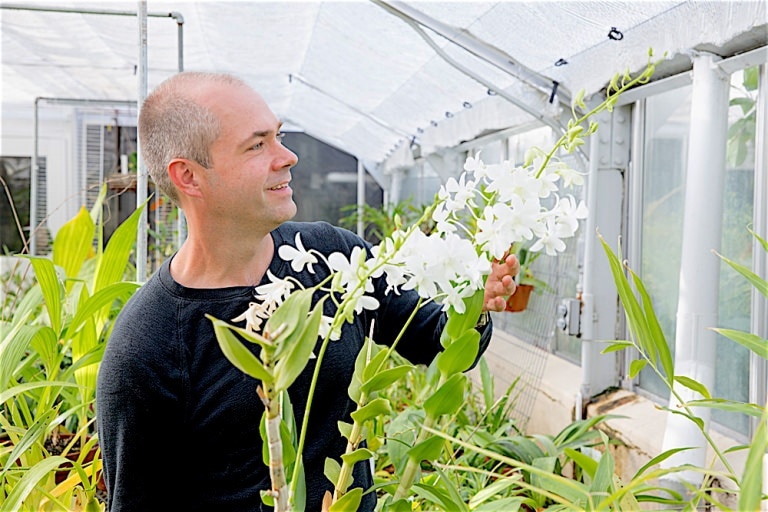Oct 17 2016
 Steve Karlen, lead author on the GLBRC designer lignin study, in the Botany Greenhouse at UW–Madison observing an orchid, a plant he sampled for the study. (Credit: James Runde/Wisconsin Energy Institute)
Steve Karlen, lead author on the GLBRC designer lignin study, in the Botany Greenhouse at UW–Madison observing an orchid, a plant he sampled for the study. (Credit: James Runde/Wisconsin Energy Institute)
In 2014, researchers announced the successful engineering of a poplar plant "designed for deconstruction.” The finding caught the attention of the global scientific community. The highly degradable poplar was the first of its kind, and could considerably lessen the energy use and cost of turning biomass into many products including pulp, biofuels, and paper.
Currently, a few of the same researchers from the earlier study are announcing an unexpected new revelation.
Nature was already doing what we thought we'd laboriously taught her to do.
Professor John Ralph, University of Wisconsin-Madison
To create the hybrid poplar, Ralph, Shawn Mansfield, Curtis Wilkerson, and other Great Lakes Bioenergy Research Center (GLBRC) researchers had integrated an exotic gene conferring weak bonds into the lignin of a plant. Lignin is the hard-to-process compound that gives plant cell walls its sturdiness but makes them hard to process in an industrial setting. The resulting lignin, referred as zip-lignin, easily breaks down when exposed to simple chemical conditions.
This new GLBRC-led research, published on October 14, 2016 in Science Advances, illustrates that those poplar trees and several other plants from all over the phylogenetic tree have evolved to naturally create zip-lignin. Not only can scientists potentially breed for degradability in plants, but humans are likely to have been doing just that - choosing certain plants for simpler processing - for centuries.
We didn't know the plants were making the native zip because we couldn't detect it. When we added the new gene we thought we were adding functionality, but we were actually increasing what was already there.
Steve Karlen, Research Scientist, University of Wisconsin-Madison
Although the team could not initially detect native zip-lignin in poplar trees or in angelica, the Chinese herb from which the researchers had borrowed the gene, its nonexistence did raise certain questions. Ralph had known for quite a while that some plants in some areas were naturally producing zip-lignin. And Karlen speculated how angelica, or any plant, could be creating the molecules that bestow weak bonds in lignin but not integrate them.
Using a technique that Ralph's team had formulated years ago, and a new and extremely sensitive mass spectrometer, Karlen sharpened his focus, discovering a method to identify low levels of native zip-lignin in poplar trees. With the assistance of Philip Harris, a professor of biological sciences at the University of Auckland in New Zealand, Karlen started a full-scale phylogenic study, wanting to establish what other plants might possess native zip-lignin.
Karlen explored gardens, greenhouses, and landscaping beds across the UW-Madison campus. Studying over 60 plant samples taken back to the lab showed that zip-lignin is found in an extremely diverse array of plants - in birds of paradise, in balsa, in all the sampled grasses, and in nearly half of the hardwoods.
Karlen also discovered the presence of zip-lignin in rice, along with collaborator Laura Bartley, an associate professor of microbiology and plant biology at the University of Oklahoma.
Since a totally different gene was responsible for producing this lignin, the team established that plants have autonomously evolved to make zip-lignin, fundamentally creating a common feature through completely different means.
Although Karlen and his partners are yet to discover out what the evolutionary advantage of native zip-lignin might be for plants, its extensive presence widens the scope of their exploration and holds out the likelihood of increasing, either via breeding or engineering, the degradability of an astonishingly enormous array of plants.
The fact that natural plants are already doing this means there are a lot more genes available for doing this than we knew about, and that means a much broader opportunity to learn from and take advantage of what these natural plants are already doing.
Professor John Ralph, University of Wisconsin-Madison